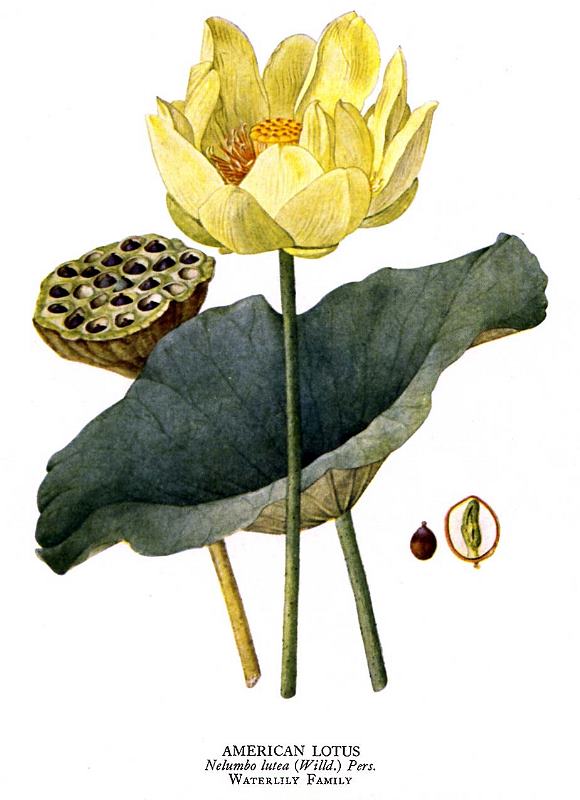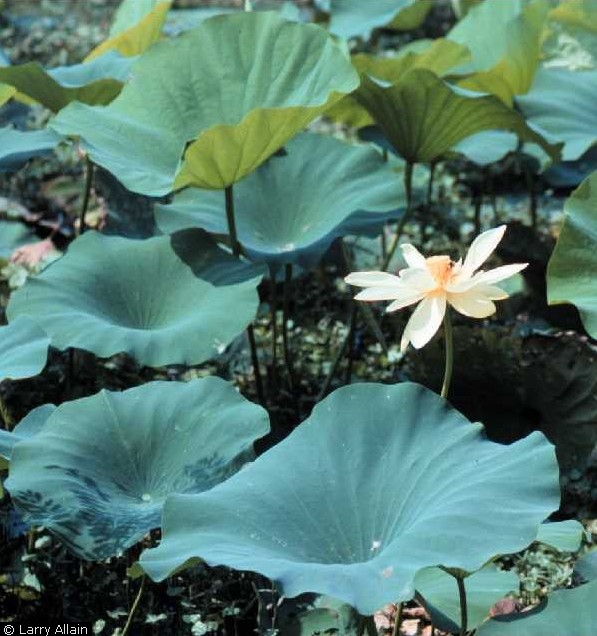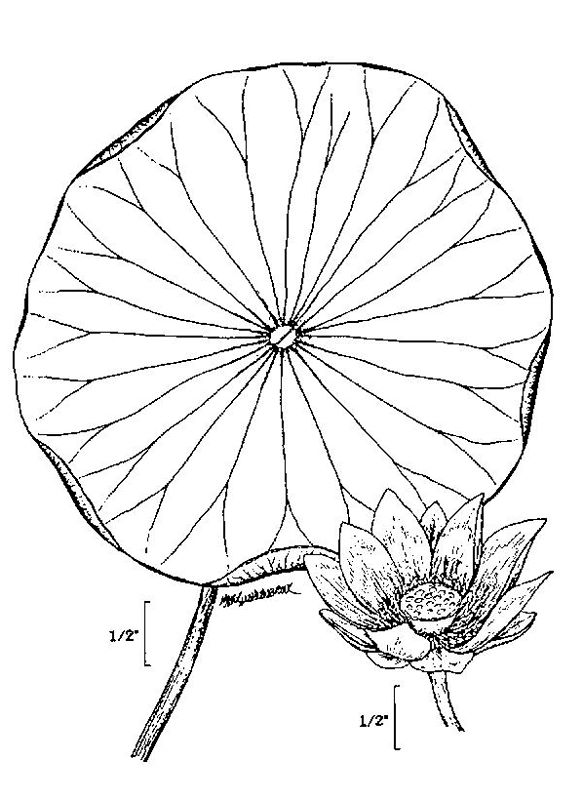Water Chinquapin, American Lotus, Pond Nut
Nelumbo lutea (Willd.) Pers.
Nymphaeceae Water Lily Family
In the regions where it grew, water chinquapin was valued for both as a food and as a sacred plant with mystical powers. Water chinquapin is an aquatic perennial with flat, roughly circular leaves from 30-60 cm wide. It grows in deeper swales, lakes, and slow-running coastal rivers. The distinctive yellow flowers and large fruiting receptacle emerge vertically from the water surface and are quite visible from a distance. Each fruit, which measures about 10 cm (4 inches) across, cradles several nutlike fruits (which look like seeds). The seeds are edible and the roots also produce underground storage tubers that are edible (Correll and Johnston 1970; Jones 1975). Long, slender, stems rise from the roots to the leaves and fruiting bodies at the water's surface. They are hollow and divided by partitions along the length of the stem. Water chinquapin is native to the eastern half of North America and grows south to Central America. The tubers, the nutlike fruits, and the vertical shoots/stems are edible.
William Bartram, while he was ascending the Mobile and Alabama Rivers in the 18th century, provides an almost mesmerizing description of a water lily stand:
. . . a large lagoon, or capacious bay of still water, containing many acres in surface, which at a distant view present a very singular and diverting scene: a delusive green wavy plain of the Nymphaea Nelumbo (eg. Nelumbo lutea): the surface of the water is overspread with its round floating leaves, whilst these are shadowed by a forest of umbrageous leaves with gay flowers, waving to and fro on flexible stems, three or four feet high: these fine flower are double as a rose, and when expanded are seven or eight inches in diameter, of a lively lemon yellow colour (Bartram 1955: 327).
Archeology. Water chinquapin has not been conclusively identified in archeological sites on the coastal plains. This is very likely due to the difficulty of recovering and identifying tubers in archeological sites with poor preservation of plant remains.
Food – roots and stems. The tubers are subterranean and are most commonly harvested by sinking one's toes into the muddy bottom and working the tubers loose from both their attached rhizomes and the muck. The tubers were then harvested with a hooked stick. The tubers were either cooked immediately or dried and stored for the winter Missouri River groups, including the Omaha-Ponca, Dakota, Winnebago, and Pawnee utilized the plant for food. The tubers were cooked with hominy or meat. Gilmore (1977:27) also notes that the tubers are roughly banana shaped, and the Omaha believed that the size of the tuber harvested depended upon the "height" of the man doing the harvesting. The Comanche also boiled the roots for food (Carlson et al. 1940). The Meskwaki and the Ojibwe utilized the shoots as greens. The terminal ends of the stems/shoots were cut transversely, strung and dried for winter use (Smith 1928:262).
Food – seeds. Gilmore (1977:79) reports that the Missouri River tribes collected and either roasted the seeds, or shelled and boiled them. The shelled seeds were often added to soups. The Meskwaki cooked the seed with corn (Smith 1928). The Ojibwe, on the other hand, would roast the seeds and make them into a meal. The meal was apparently sweet. Thomas Nuttall gave a detailed description of seed/fruit preparation by the Quapaw in Arkansas. The seeds were soaked in water, parched in hot sand and separated from the shell. Then they were prepared in a soup (Nuttall cited in Austin 2004:454). William Bartram (1955:327 ) remarks that the seeds have a sweet flavor.
Medicine and Ritual. Gilmore (1977:79) notes cryptically that the groups of the Missouri River considered water chinquapin to have mystic powers, but he did not elaborate. The Potawatomi used the roots as a poultice to heal inflammation (Smith 1933). Although the quality is not specifically mentioned as a medicinal application, Bartram (1955) notes that the seeds had a laxative effect. This quality could be put to good use in our fiber-poor diets of the 21st century.
References
Austin, Daniel F.
2004 Florida Ethnobotany. CRC Press (Taylor and Francis, LLC). London.
Bartram, William [ed. by Mark Van Doren]
1955 Travels of William Bartram. Dover Books, Inc.
Carlson, Gustav G. and Volney H. Jones
1940 Some Notes on Uses of Plants by the Comanche Indians. Papers of the Michigan Academy of Science, Arts, and Letters 25:517-542.
Correll, D. and M. C. Johnston
1970 Manual of the Vascular Plants of Texas. Contributions from the Texas Research Foundation, Volume 6. Renner, Texas.
Jones, Fred B.
1975 Flora of the Texas Coastal Bend. Welder Wildlife Foundation. Sinton, Texas.
Smith, Huron
1928 Ethnobotany of the Meskwaki Indians. Bulletin of the Public Museum of the City of Milwaukee 4: 175-326.
1932 Ethnobotany of the Ojibwe Indians. Bulletin of the Public Museum of Milwaukee 4:327-525.
1933 Ethnobotany of the Forest Potawatomi Indians. Bulletin of the Public Museum of the City of Milwaukee 7:1-230.


